The true story of how my dad made the mint
He designed the first decimal coin, and now Virginia Ironside’s father is getting one of his own

Had my father, Christopher, been alive to witness the Royal Mint issuing, this week, to celebrate the centenary of his birth, a previously unminted 50p coin, I know what his reaction would have been. “Oh God, I hope they’re not going to ask for a ‘minor change’.”
That was always his fear. Because when Sir John Betjeman, the Duke of Edinburgh and Garter King of Arms were on the mint committee when he was designing the backs of the first decimal coins in the 1960s, they would often ask for minor changes which would always throw the design completely out of kilter. “They don’t realise that if I get Britannia leaning backwards slightly, I have to re-do all the lettering!” he’d complain.
What I most remember about my father designing the decimal coins was the secrecy surrounding it all. As an artist – he was a painter and taught life-drawing at the Royal College of Art – he’d been chosen as one of many designers to submit designs to a Royal Mint Committee, but it was essential that no one knew anything about it.
And when his designs were finally chosen, we lived a kind of cloak-and-dagger life. The coins were designed on paper, and then worked in reverse into large deep circles of plaster. They would then be cast back to positive and my father would work on them, then cast them back to negative and so on.
He used to sit hunched over his drawing board in the sitting room, jabbing away at the plaster with a sculpture tool, peering at the tiniest detail through a large magnifying glass. Whenever anyone came round (even the window cleaner) odd bits of cloth had to be hastily thrown over the designs, and the plaster casts were stacked out of sight. Everything was done on the telephone and letters arrived marked “Strictly private”.
Everything went swimmingly until, in 1966, James Callaghan, the new Chancellor of the Exchequer, announced that we would be switching to decimalisation. He also announced that the previous design decision, which my father had won, should be scrapped and there should be an open competition with everyone submitting their designs anonymously.
After fortifying himself with a couple of gin and tonics, my father nobly started all over again. He was determined to win for a second time – this time using a pseudonym. He did dozens of designs. My stepmother remembers being faced, once, with 15 images of St George. “Which do you like best?” my father asked. “St George naked, or St George with armour?”
Sometimes she would pose for Britannia, holding a ruler instead of trident, as my father would command “Back a bit!” “Forward a bit!” to get the posture right.
Eventually, Arnold Machin won the competition to do the Queen’s portrait, but my father was commissioned to design the reverses of the coins. They finally made their appearance in 1968. My father would later design the coinages of Tanzania, Brunei, Bahamas, Qatar, Dubai and Singapore.
I remember him explaining why he never signed his coins. “There are three reasons,” he said. “The first is that it would spoil the design of the coin. The second is that it’s arrogant.” The third, he said, “is that it is even more arrogant not to sign them. The work of a great many artists who are geniuses is never recognised and probably eventually disappears.
“But if one is a coin designer, one’s work lasts long after death. It forms a part of the history of the country for which it has been designed and one became famous. Not because one is a genius or a saint or a monster, but simply because one is a coin designer.”
Subscribe to Independent Premium to bookmark this article
Want to bookmark your favourite articles and stories to read or reference later? Start your Independent Premium subscription today.

Join our commenting forum
Join thought-provoking conversations, follow other Independent readers and see their replies